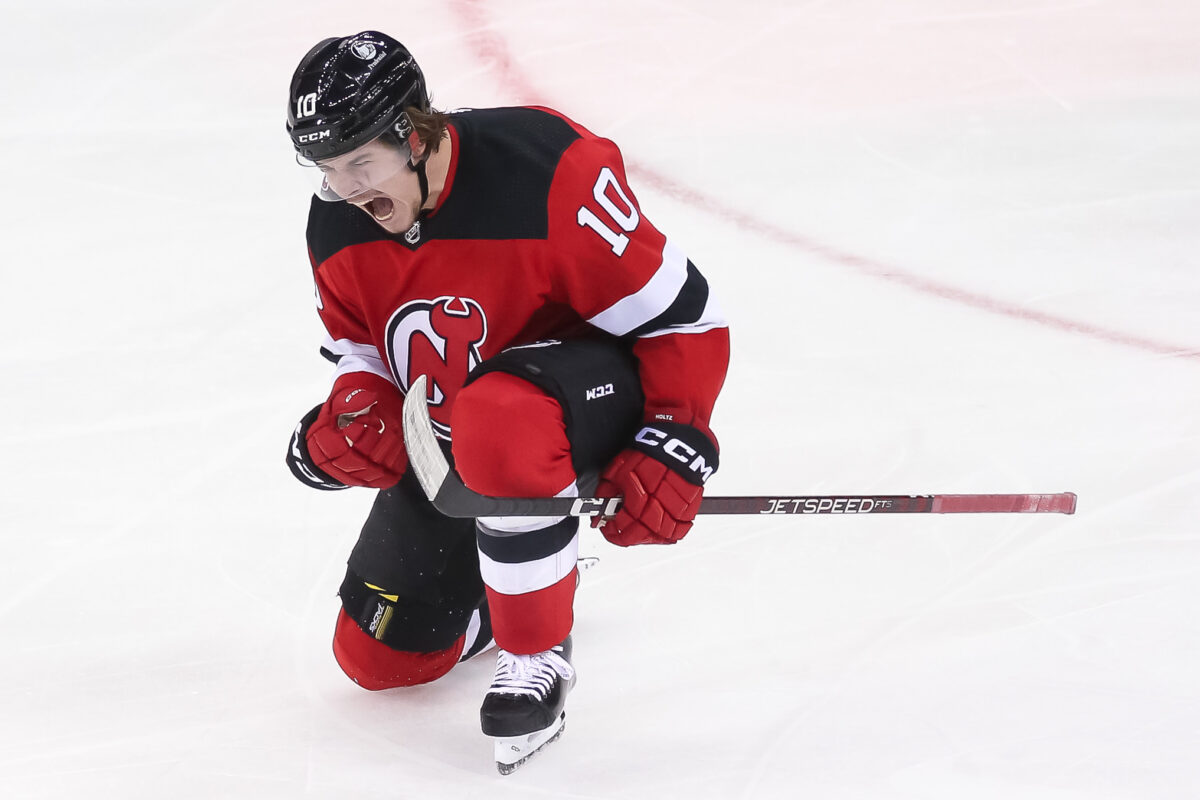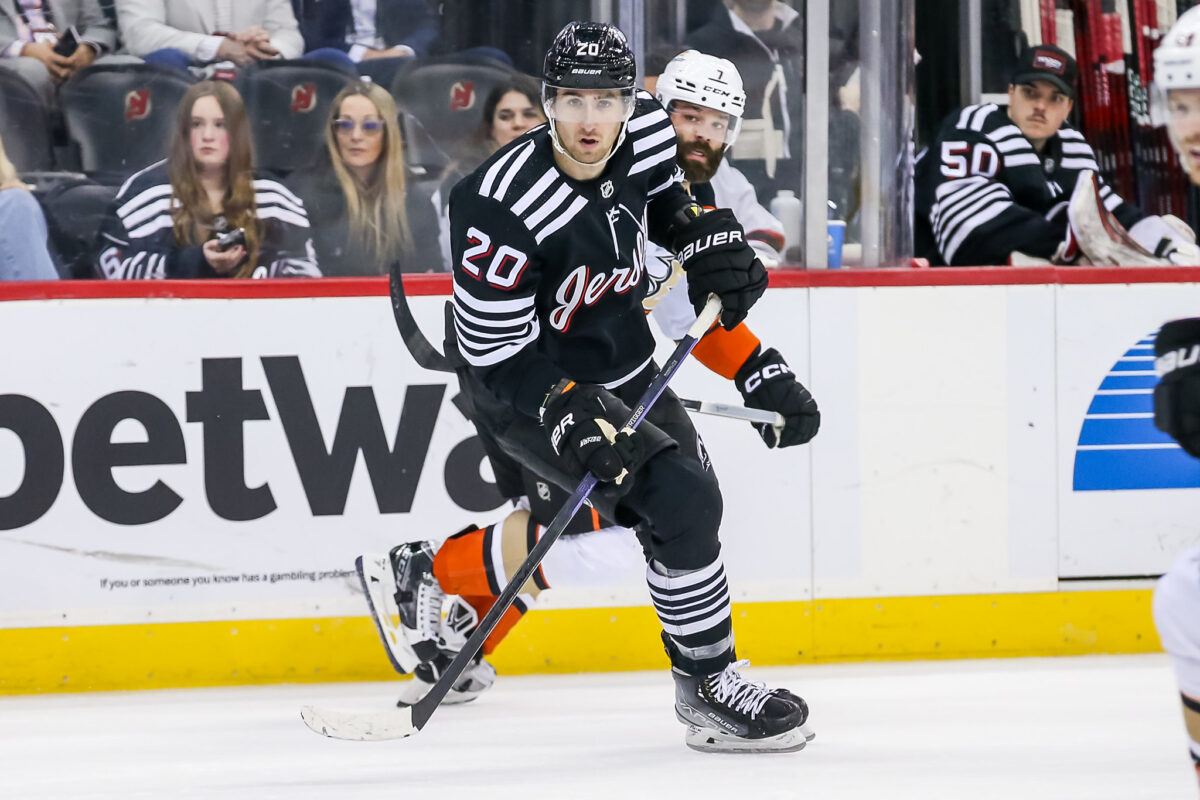Heading into 2023-24, the New Jersey Devils were not wanting for offensive firepower. They had an offense consisting of superstars Jack Hughes, Jesper Bratt, and Timo Meier and a solid group of secondary scorers that could each easily net 30 goals in Nico Hischier, Dawson Mercer, and Tyler Toffoli. Add in one of the NHL’s premier offensive defensemen, Dougie Hamilton, and rookie Luke Hughes, and the Devils were poised to challenge for the league’s scoring lead. At the time, the team figured it could park Alexander Holtz on the third line, give him sheltered 5v5 minutes, and allow him to grow his game apart from the scoresheet. In some ways, it has worked spectacularly; in others, the former 2020 seventh-overall draft pick is still finding his way.
Make or Break Offseason
The Devils sent Holtz off into the offseason with a caution that he was running out of time and that this would be a make-or-break year for the young Swede. He spent his summer engaged in fierce workouts with teammate Bratt and others, improving his speed, strength, and agility. His improvements were noticeable from the first days of training camp and signaled to anyone paying attention that he had locked down the roster’s final forward spot. Heading into the regular season it was clear he would be in the lineup, just unclear as to whose line he would join.

Holtz spent much of last season shuttling between the practice rink and the scratch suite, a victim of the team’s continued success. He finished the season mostly in the American Hockey League (AHL) with the Utica Comets, getting consistent ice time until a late-season injury shut him down. At the end of the season, general manager Tom Fitzgerald took responsibility for the rocky year Holtz experienced, indicating that he should not have allowed the rookie to languish on the outskirts of the NHL team as long as he did and that he should have sent him back to Utica earlier to get him more playing time. The coaching staff and front office indicated they expected more from Holtz this season and would give him every opportunity to make the team out of camp and contribute.
RELATED: Devils News & Notes: Power Play, Goaltending & More
Contribute he has, as Holtz has filled in admirably throughout the lineup in a myriad of roles from the first to the fourth line and everywhere in between. While lacking a consistent line and often consistent ice time, the forward still has career-high numbers and is on pace for a 20-goal, 40-point season in his first full year of action. His shot has been elite, as advertised, and his ability to get a shot off quickly and in traffic shows why he was drafted in the top ten. He has also demonstrated improvement in the other facets of the game, playing away from the puck, winning board battles, and being a factor in all three zones. How he improves in these areas will go a long way toward determining his role as the team fights to make the playoffs.
Are Points Alone Enough to Earn Ice Time?
In past seasons, Holtz was expected, at a minimum, to contribute offensively. This season, his scoring is expected to be a given, but to earn more ice time, he must play well in all three zones. He has responded by leading the team, along with Dawson Mercer, with ten 5v5 goals and is second to Bratt with 19 5v5 points. When the team scores with him on ice, he is usually a reason why, having earned a point more than 80% of the time, a goal was scored on one of his shifts. He is also tied with Mercer for the team lead in 5v5 shooting percentage (16.95%) but is significantly behind him in high-danger chances and scoring chances overall and per 60 minutes.
Holtz’s performance in the offensive zone this season is undeniable; he currently leads the team in 5v5 points per 60 minutes. Many have tried to ascertain why he has had his ice time diminished, even with the absence of Hughes, Palat, Meier, and others. The reason seems to lie in the defensive metrics with him on the ice at 5v5. The team’s expected goals-for percentage (xGF%) with Holtz on the ice at 5v5 is 47.83, which places him 11th on the team amongst forwards. The Devils have given up 20 more high-danger chances than they have earned with Holtz on the ice at 5v5.

In a smaller sample size, since Hughes went down with an injury against the Chicago Blackhawks, Holtz has struggled. His xGF% plummeted to 33.28 at 5v5, tenth amongst forwards. In those four games, with Holtz on the ice, the Devils have been outshot, out-chanced, outscored, and given up 14 high-danger chances while only registering three of their own. It seems clear that pairing Holtz with Lazar and Tierney has not been productive for the forward.
How Should Holtz be Deployed?
The arguments over whether Holtz belongs in the top six, middle six, and/or the bottom six have raged on for the entire season. While line placement does not seem to be a determining factor in his success, it appears that he plays better with certain teammates and vice versa. In examining his play on lines centered by Hughes, Hischier, or McLeod, certain characteristics are apparent. Holtz plays best with a speedy, play-driving center who will create space for his shot.
Of the three centers, Holtz’s numbers with Hischier are the worst. In a short sample (16 minutes), the Hischier-Holtz combination played to a 34.92 xGF% and a .857 save percentage (SV%) and was outshot and outscored. When paired with Hughes, the numbers improved dramatically. The line played to a 65 xGF% but the goals were even despite having 67% of the scoring chances and 60% of the high-danger chances. The best match of the three for Holtz has been McLeod. McLeod is having a breakout season, and many players have played better beside him this season, but with Holtz, the difference is stark. In just over 107 minutes together, lines with Holtz and McLeod have outscored opponents 13-3, vastly outplaying the xGF% of 57. These numbers are further reflected in the shooting and save percentages of 19.7 and .937, respectively.

It seems the complaints about Holtz being stuck on the fourth line are well founded, as in games where he played with any other center, his production significantly dipped. In those 268 minutes, the Devils were outscored 15-9 and played to an xGF% of 35. The team and Holtz thrive when he is in the top nine with McLeod or Hughes. With Hughes out and McLeod centering the second line, Holtz has struggled to produce. One option would be to try him with Hischier and see if extended time unlocks his offense or to find a way to move him up to McLeod’s line, which may mean moving Toffoli or Erik Haula to the third line. Ideally, finding a way to reform Holtz, McLeod, and Lazar makes sense. In 52 minutes together, the line has outscored opponents 8-1 and played to a shooting percentage over 27 while being incredibly defensively responsible, resulting in an on-ice SV% of .964.
Holtz is a valuable part of the Devils’ present and future. His production has rewarded the faith and patience of the organization that invested heavily in his development. He has shown that he plays better when put in positions to succeed, especially when paired with linemates with speed and the ability to drive the net, creating space for him to deploy his elite shot. Finding a way to keep him on a line with McLeod and/or Hughes should benefit the Devils moving forward.
